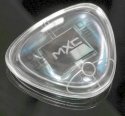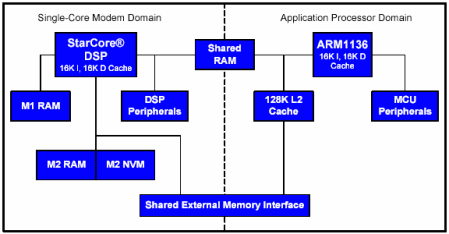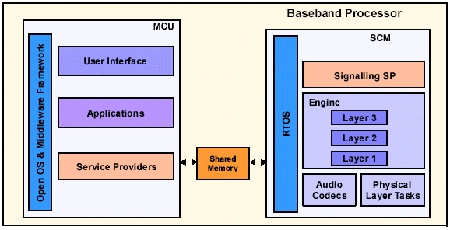Linux phones home on high-integration mobile phone chip
May 17, 2005 — by Henry Kingman — from the LinuxDevices Archive — views Freescale used embedded Linux to complete the first call on a postage-stamp-sized SoC (system-on-chip) designed to bring mobile/cellular networking capabilities to a wide variety of consumer devices, it says. The MXC275-30 SoC is the first of Freescale's Mobile Extreme Convergence (MXC) chips, designed to bring “form factor freedom” to mobile phone makers.
Freescale used embedded Linux to complete the first call on a postage-stamp-sized SoC (system-on-chip) designed to bring mobile/cellular networking capabilities to a wide variety of consumer devices, it says. The MXC275-30 SoC is the first of Freescale's Mobile Extreme Convergence (MXC) chips, designed to bring “form factor freedom” to mobile phone makers.
(Click for larger mock-up of Freescale's concept portable media player)
MXC architecture
Freescale's MXC line comprises “cellphone-on-modules” intended to radically simplify mobile phone design. The line was first unveiled by Motorola in October of 2003. Motorola spinoff Freescale announced that it had begun sampling the chip in February of 2004, with former parent Motorola being the first disclosed recipient.
In general terms, the MXC architecture implements two processor cores on a single piece of silicon — a Freescale StarCore DSP (digital signal processor) with VLIW (very long instruction word) instruction processing capabilities, and an ARM1136 RISC application processing core (see block diagram, below).

MXC hardware architecture (based on an early MXC processor concept)
The DSP runs a real-time operating system (RTOS) and implements all modem and communications functions, while the ARM core runs a general purpose operating system and handles the user interface and various software applications. The DSP and ARM processors communicate with each other via a small amount of on-chip shared memory, using mailboxes that contain pointers to off-chip data memory. According to Freescale, this software architecture eliminates the need for real-time capabilities in the OS that runs on the applications processor (the RISC core).

MXC software architecture — communications and application software are partitioned on separate processor cores
(Click to enlarge)
Linux a priority
According to Jose Corleto, Freescale's systems and architecture manager, the MXC275-30 booted Linux less than a week after the first sample silicon arrived. The chip will ultimately run a variety of embedded operating systems, but Corleto said that for now, Freescale is “focusing our efforts on Linux.”
The MXC275-30 made its first call while running an unspecified version of Linux, Corleto said, on an EDGE network simulator in Freescale's lab. Corleto says that the chip does not require a specialized version of Linux, because of a clean separation between application processing and DSP/modem control processing.
The MXC275-30 replaces about 30 chips in current phone designs, Freescale claims. Potential applications include mobile phones with increased battery life and smaller form-factors, portable media players that can connect to media vendors to download songs and movies, multiplayer network gaming devices, and a variety of industrial embedded applications.
The MXC275-30
The MXC275-30 is powered by a 532MHz ARM1136JF-S core, in league with the 208MHz StarCore DSP core that runs the RTXC OS from Quadros; the ARM core has its own L1 cache and MMU (memory management unit). Corleto says Freescale's collaborative single-core modem team has successfully moved a GSM signaling stack to the StarCore DSP — freeing up the ARM11 core for application processing — and will port WCDMA signaling next.
The cellular modem included in the MXC275-30 is a quad-band EGPRS Class 12/GPRS Class 12 with simultaneous voice and data capabilities. It covers the 850/900/1800/1900 MHz bands.
The MXC275-30 also integrates a single memory subsystem, an RF (radio frequency) transceiver, a power amplier, LCD and touchscreen controllers, and power management hardware. The chip can support streaming CIF (352 x 288) video at 30fps, using MPEG4/H.264 compression, and includes image capture capabilities as well.
Corleto says the MXC275-30 will offer power savings of about 40 percent over current mobile phone chips, while shaving about 35 percent off a mobile device's BOM (bill of materials). It will work on any network that serves EDGE/GPRS, Motorola's 2.5G technology marketed as a midway step toward 3G for carriers, since it can run on existing network infrastructure.
Availability
Corleto said that devices based on the MXC275-30 could appear as soon as Q4, 2005. Freescale is currently working on an “MXC 27530” evaluation board for the chip.
Corleto will deliver a talk entitled “The MXC275-30 EDGE Processor from Freescale Semiconductor” at In-Stat's Spring Processor Forum this week in San Jose, Calif. The talk will take place on Wed. May 18, during the Advanced DSP Engine session, according to Freescale.
Freescale will also demonstrate the MXC275-30 — including using it to make a live call, it says — at its inaugural Freescale Technology Forum, set for June 20-23 in Orlando, Fla.
Additional details about Freescale's MXC architecture and chips, including architecture diagrams and a whitepaper download, can be found here.
Mobile market forecaster Foreward Concepts said in April that Freescale is gaining ground on mobile chipset marketshare leader Texas Instruments — as is Qualcomm, which announced Linux support on one of its chipsets two weeks ago.
This article was originally published on LinuxDevices.com and has been donated to the open source community by QuinStreet Inc. Please visit LinuxToday.com for up-to-date news and articles about Linux and open source.